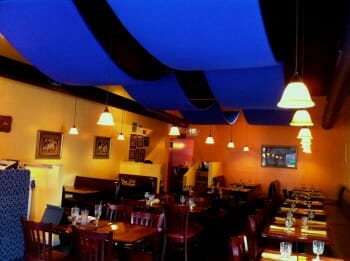4 Restaurants with Great Acoustic Design
As perceptions of what constitutes luxurious environments and trends in food service have evolved, restaurant design has more and more favored large, open spaces and hard surfaces. And this is having a serious effect on restaurant noise levels. 
In the race to create sumptuous and modern aesthetics, many of the decorative features which used to provide organic sound absorption have fallen out of fashion. Higher-end dining environments used to be lush with carpeting, table cloths, and wallpaper, but now polished granite counters, marble table tops, ceramic or hardwood floors, open kitchens, exposed brick, and bare walls have taken over.
The surge in highly-reflective surfaces has led to serious noise problems for restaurants and their customers. Certainly, a bustling atmosphere can be desirable and inviting – after all, nobody wants to eat in a mausoleum – but, quite often, the noise in restaurants can be literally deafening. So, it should come as no surprise that restaurant noise control is an increasingly important subject in the food and hospitality industry.
Normal conversation works best between 55 and 65 decibels, but typical restaurants can rate as loud as 85 to 100 decibels – that’s on par with your average jackhammer or a jet taking off. Bear in mind: beyond 75 decibels conversation becomes difficult, and at 85 decibels, inner ear damage can lead to permanent hearing loss.
For the more than 1 in 10 Americans who suffer partial or severe hearing loss, this can make dining out a non-starter. According to the 2018 Zagat Dining Survey, noise topped the list of customer complaints. In fact, many restaurant critics now bring decibel meters with them and include acoustic quality along with ambiance, service, and food quality in their restaurant reviews.
Balancing Sound Absorption in Restaurants
Sound absorption solutions for restaurants require a balancing act: diners want a comfortable level of noise that will allow them to enjoy conversation, while restaurant owners still want some level of noise to ensure a perception of popularity and enjoyment within their establishments.
4 Restaurants’ Solutions for Acoustical Issues
1. CōV Wayzata, Wayzata, Minnesota
CōV Wayzata features an open kitchen and bar, and it could get uncomfortably noisy during peak business hours.
To absorb and disperse sound, they raised the ceiling and installed a mix of acoustic panels and wooden slats. They’ve left the kitchen and bar open, but the noise these areas generate provides background ambiance which helps guard patrons’ conversational privacy while enabling them to speak with each other at comfortable levels.
2. Oliveto, Oakland, California
Oliveto also features an open layout in which both the bar and kitchen are open to the dining area. The owners didn’t want to simply reduce noise, so they employed a two-fold solution that enables them to directly control the acoustics according to how busy the restaurant is.
First, they installed a passive acoustic system in the ceiling made from sound absorbing tiles. They also installed a combination of microphones, signal processors, and small speakers – all discreetly incorporated within image panels and complementing the overall aesthetic. Using an iPad, they can now directly shape the acoustics of the restaurant to make it sound busier at quiet times and to lower sound levels when the restaurant is busy.
Silk Metal is another fantastic product that’s easily installed into drop-ceiling T-grids. It works on a wide range of frequencies, and it boasts an NRC of 0.80. Since it’s made out of aluminum and not fiber-based, it can also be steam-cleaned, and this should make it a very attractive option for restaurant owners since hygiene and sanitation figure so prominently for them.
3. Untitled, New York, New York
Untitled consists of a wide-open space with high ceilings, walls of glass and concrete, and limestone flooring. It also features an open kitchen, and there isn’t a tablecloth in sight. By all accounts, you’d expect the restaurant would reflect and amplify every sound, and yet conversation is heard crisply, without distractions from music, background noise, or voices from neighboring tables.
They’ve coated the ceiling with a porous acoustic plaster called Baswaphon. It absorbs sound much like a sponge soaks up water, so the restaurant retains its distinct, contemporary aesthetic without descending into ear-splitting cacophony.
Similar to Baswaphon, Microperf micro-perforated panels represent an entirely new class of decorative sound-absorbing wall and ceiling panels. These decorative panels provide exceptional acoustic performance in tandem with pleasing design features that can be easily incorporated into any aesthetic.
4. Boba Latte, Richardson, Texas
Boba Latte specializes in tea, coffee, and smoothies – the kind of environment that lends itself to quiet conversations or reading. Their minimalist design, however, caused unwanted echoing, and the owners wanted to create an acoustic environment which would allow for casual conversations while allowing customers to relax and enjoy their time there.
Solving the problem required a slight change to the restaurant’s aesthetic. They installed colored acoustic tiles on a wall at one end of the restaurant that now acts as a sound absorber as well as serving as an attractive accent to the overall white-on-white color scheme.
 Another very affordable, high-performance solution in this type of scenario would be to use Echo Eliminator™ sound absorbing panels. They’re made from recycled cotton, and they can be used easily attached to wall panels or suspended from ceilings as hanging baffles. They’re as effective as fiberglass, and they contain no volatile organic compounds.
Another very affordable, high-performance solution in this type of scenario would be to use Echo Eliminator™ sound absorbing panels. They’re made from recycled cotton, and they can be used easily attached to wall panels or suspended from ceilings as hanging baffles. They’re as effective as fiberglass, and they contain no volatile organic compounds.
For another great, high-performance sound blocker and absorber, try the STC and NRC rated Sound Silencer™ panels. They’re affordable, Class A fire rated, and they resist moisture, impact, bacteria, and fungi. They can be employed in both ceiling and wall applications, and they’re great for food-related environments.
Conclusion
Shaping restaurant acoustics is as important as establishing décor, service, and food quality, and each restaurant owner should understand the wants and needs of their prized customers. While this may be a challenge, there is no shortage of dynamic, affordable, and aesthetically attractive solutions. Visit Acoustical Surfaces to view our full range of acoustical products or to get customized solutions and products for your restaurant.



